Email marketing is one of the easiest and most effective ways to keep in touch with your target audience. Whether you’re nurturing leads or trying to drive repeat purchases by re-engaging existing customers, email is a great way to do it.
However, there’s a lot to consider when it comes to email content that will get high open rates, clicks, and conversions. For starters, you need to have a great email marketing strategy. Your email subject lines have to be exceptional. You gotta nail your email design. And it’s imperative to have strong autoresponders, including a welcome series.
The list goes on and on.
And, of course, you need exceptional email body copy, which will drive clicks to your landing page, keep your readers’ attention, and ideally, drive results like sales.
So that’s going to be the focus of this post. We’re covering all things email marketing copy, including why it matters, how to write a marketing email, best practices, tools, and more.
Ready to roll?
Subscribe to our weekly newsletter for tips so good that we might put ourselves out of business.
What is email copywriting & why does it matter?
Email copywriting includes creating the marketing messaging for an email. For this post, we will be looking exclusively at the copy in the body of the email, which will make up the majority of an email message.
(Want help with email subject line copywriting? Check out our post here).
Email body copy can primarily be used to educate readers (think a content marketing-styled approach) or persuade them to take action (often a sales email).
These actions could include checking out your new product launch, signing up for a waitlist, creating a wishlist, entering a contest, subscribing to a webinar, or making a purchase.
No matter what, though, all of your email copywriting should be
- well written
- on-brand
- clear and to the point
- visually easy for subscribers on your email list to read
- direct and leave your email subscribers no questions about what they should do next
Think of your email copywriting as the voice of your brand. You’re talking directly to your audience and can sway them into action.
8 email copywriting best practices
Email copywriting seems straightforward, but it actually requires some practice, strategy, and careful execution. (Sprinkle in a heavy dose of creativity, too. 😉 )
However, these eight marketing email copywriting tips will make your job much more manageable and make it easier for you to create stronger email marketing copy that will boost your click-through rates and conversion rates.
We’ll also look at some email copywriting examples to show you how to execute the strategies, too.
Without further ado, here's how to write a marketing email through eight simple best practices.
1. Understand your audience to speak their language
You should never do anything in digital marketing without having a firm grasp of your audience.
What do they want? Which problem can you solve? What are their specific pain points, motivators, and needs—and how do you fit into that picture? Do they have concerns or objections?
Just as relevant is what messaging will they respond to, and what language will resonate with them most? Do they prefer informal and casual tones? What sort of language and words do they use to describe their most significant issues?
We strongly recommend creating buyer personas as part of your email marketing strategy and then crafting specific email body copy based on them to persuade users that your product or service is perfect for them.
Here’s a great email copywriting example from RockinGreen. The message asks if the reader has issues with laundry (white streaks, stiff clothes, water stains) and then recommends products based on their answers. It addresses a core problem and presents their product as a solution, all through the lens of the audience.
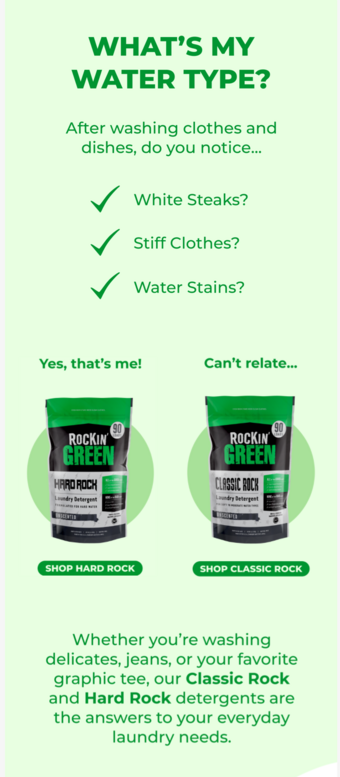
Here’s another example. I’ve been a Grove customer for a while and have exclusively purchased plastic-free, sustainable products from them. They sent out this email that focused on “tree-free” products, stressing the environmental impact in a way that would resonate with audience members like me.
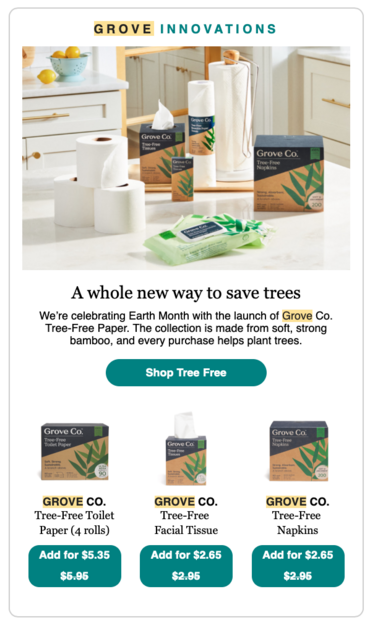
2. Pay attention to the subject line
As we mentioned, we’re not focusing on email subject lines in this post. However, we’re also not going to overlook the fact that they can play a crucial part in the overall email copy.
Your email body copy will be most effective when it refers back to the subject line in some way. It keeps readers engaged because they don’t feel like there was a bait and switch, and it helps drive your message home.
This can be simple, like using similar or repeating words in the subject and body copy, as you can see in the example below. Both the subject line and body copy use the words “hues” and “warm weather” prominently:
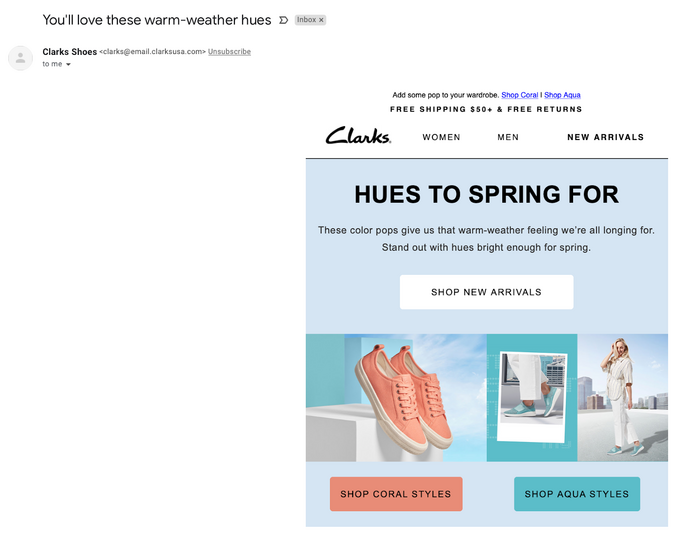
Similarly, you can start a thought in the subject line and continue it in the copy (like asking and answering a question):

Or, you can consider another unique approach. A local farm near me will add emojis of their “crop of the week” to the email subject line, which is a great way to get readers excited to make it all the way to the product section at the bottom of the email.
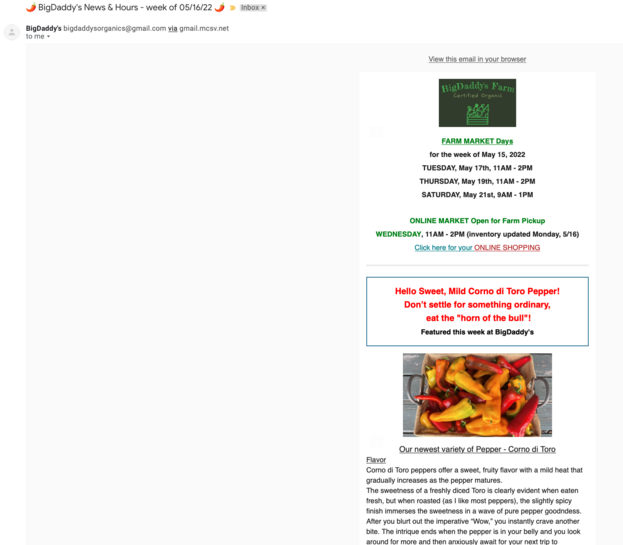
3. Personalize the emails as much as possible
Personalization is invaluable in email marketing campaigns. Use it as often as possible.
It’s an outreach strategy that will help build a relationship with readers. It increases their attention and engagement levels, and since you’re offering true-to-them suggestions, it boosts the odds of conversions, too. (In fact, it’s said that 91% of consumers are more willing to purchase from brands that recommend relevant offers to them.)
Personalization can include offering customized recommendations based on a customer’s browsing or purchase history.
It can also mean personalized text shoutouts, like using the customer’s name. In the example below, HomeAgain used one of our dogs’ names (Juneau) in the subject line and the body copy.

4. Keep your email copy brief
Writing an email newsletter? Crafting a sales-heavy product announcement? What about a webinar promotion?
Doesn’t matter. Try to realistically keep email copy brief and to the point.
Of course, something like a newsletter might require a bit more real estate, but even so, aim for brevity and precision.
Most emails should be 50–125 words. Like we said, even content-focused emails (like newsletters) should be kept relatively short and link to longer resources as necessary.
And don’t forget—around 81% of users open emails on mobile, so brevity has never been more critical.
Keep this in mind with your preview text, too; put the most important information up front and be as concise as possible so that readers can get a good idea of the message before opening.
This snippet of text can, in fact, increase open rates significantly to help you get better email results. You can email A/B test to find the winning email length for your brand.

5. Incorporate branded language
Your brand voice is everything. Know it well and use it often.
Brand voice should embrace who you are as a business (or business owner) and the feeling you want customers to get when purchasing from you.
You can be funny, flirtatious, quirky, assertive, or even a bit bold if you want. Whatever it is, it should be consistent, and it must be authentic.
One of my favorite companies right now that absolutely crushes every part of creating a brand voice and experience is Who Gives A Crap. (Seriously, check out every aspect of their marketing.)
These emails showcase their playful, youthful brand voice. See this in the example here, which even has a CTA of “Wow wow wow!”

And here’s another from Who Gives A Crap. This copy feels almost meta, calling out that they have a copywriter in the subject line. But they still playfully offer an update about products while showing that they value their employees at the same time:
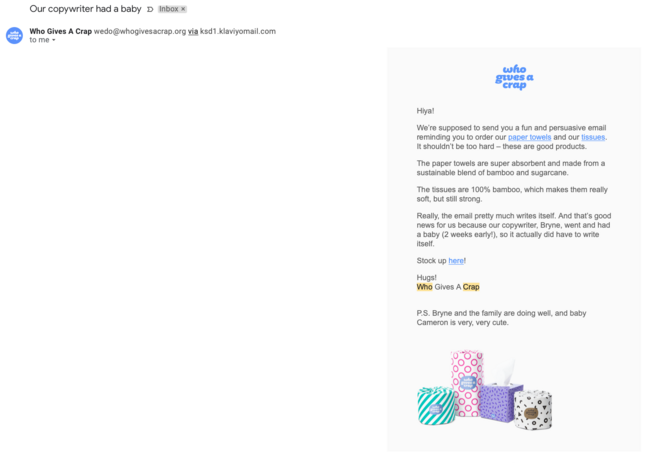
6. Have direct CTAs that are always visible
Call-to-actions (CTAs) are a vital part of every single email.
They should always be visible, and they should always be extremely direct.
Imagine emailing your clients with a follow-up retargeting campaign to get them to purchase on an abandoned cart… but you don’t link back to your online shop.
What gives?
Your customers are now responsible for navigating back to your site, and if it’s not exceptionally easy, they’re way less likely to take that action. So always include a CTA, make it visible, and make it direct.
Your CTAs should
- create a sense of urgency
- make it easy to understand what action you want users to take
- make it simple for users to take that action
- include power words and action word combinations like “Shop Now” or “Start Boosting Income Today”
- be written in the first person (e.g., “Take Me There”) instead of the second person (e.g., “Take You There”)
See an example here, where the CTA encourages readers to “Read and shop,” taking users to a blog post that then links to products available for purchase. This is a great way to engage potential customers and build sales intent.
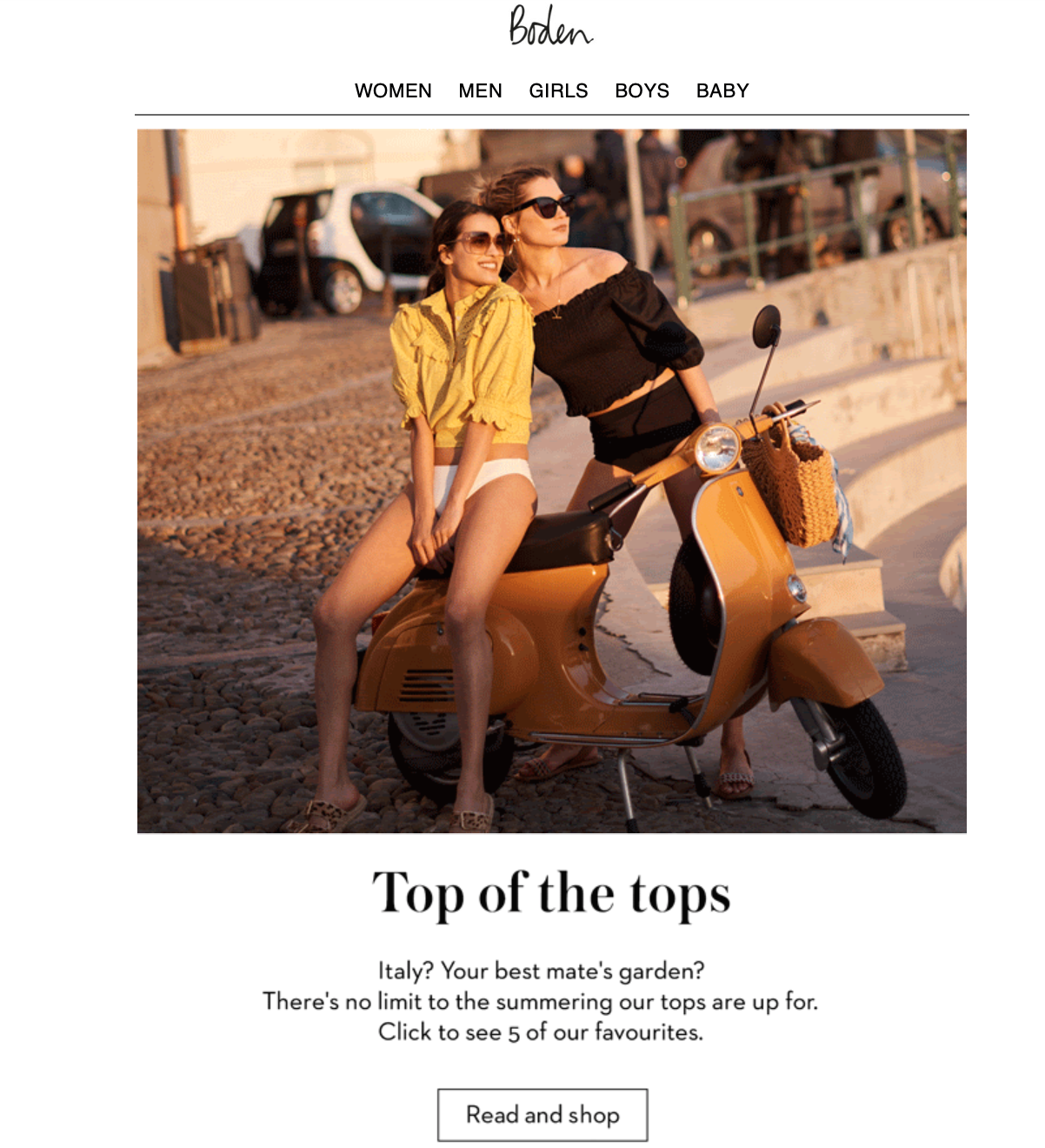
And here’s another example. This company has a CTA for women’s attire and a separate one for men’s. This makes it easy for each audience segment to get to the relevant landing page right away.
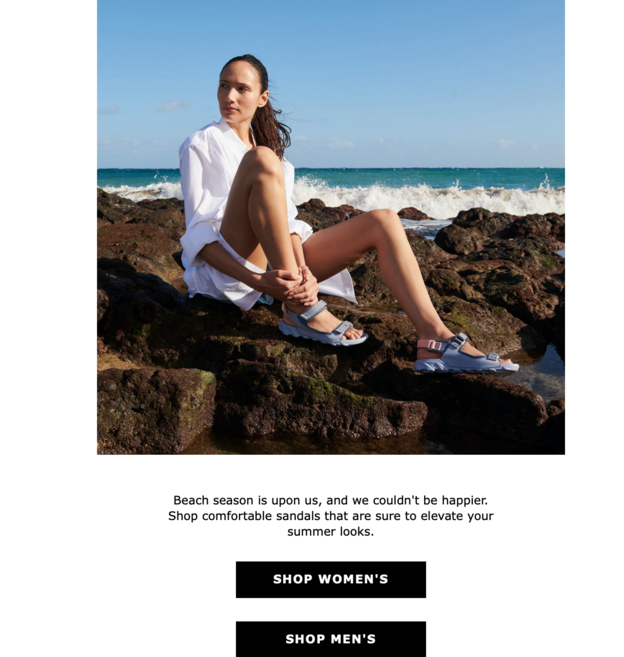
7. Always A/B test your email copy
This is going to be a short section, but it’s an important one. (For a deeper dive, we wrote an entire article on email A/B testing.)
If you want to excel with email copywriting, you need to be A/B testing your emails for each audience segment.
There are plenty of tools that can help, including Mailchimp and ActiveCampaign. They’ll let you send two versions of an email to an audience segment and see which are opened and clicked more.
Remember to test just one element at a time. That can be the images, the email design, the subject line, or the body copy.
Within the body copy (since that’s what we’re dealing with here), you might test
- the tone of the copy
- including emojis or GIFs
- the length of your copy
- punctuation
- in-image copy vs. plain-text copy
- so much more
8. Have fun with it
Lastly, have fun with it.
Some of the best emails and copywriting come from really creative and fun experimentation.
This isn’t just a tip that’s particularly important for “fun” brands. Whether you’re a B2B brand or an eCommerce one, you want to keep your email list excited about the messages and unlikely to unsubscribe.
A great way to do that is to have fun with your copywriting and let that shine through.
Don’t be afraid to get creative, as long as you’re following all the other best practices. You shouldn’t use spammy words or tactics, but you could try out a play on words, rhymes, puns, or emojis to keep things interesting.
Check out the example below, which has the subject line “Show us what you’re into” and a body copy headline of “A flirtation with inspiration.”
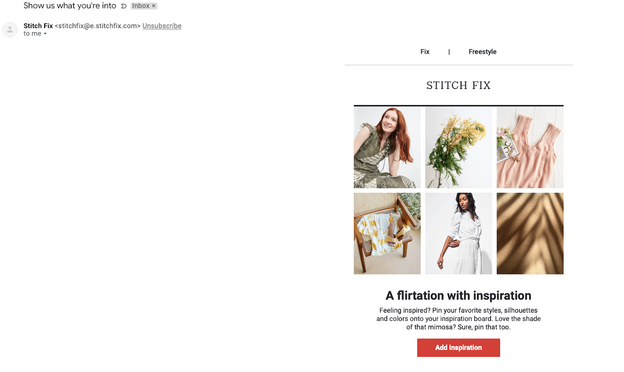
Email copywriting tools that can maximize conversions
Want to take your email marketing copy to the next level? Or maybe you just need a little assistance getting started?
There are plenty of email copywriting tools that can help. These are some tools you can use to create newsletters, promotional emails, and autoresponder campaigns:
- Any email marketing software. Mailchimp, HubSpot, ActiveCampaign, you name it. They’ve all got email templates that can inspire you, get you started, and help you see where different sections of the body copy (like headlines or extended descriptions should go).
- Grammarly. Grammarly can be used on Google Docs or even in email software (including Gmail) to ensure that your copy is error-free.
- Automation tools. One of the most significant benefits of email automation is sending the right message to users at the right time. Tools like Zapier and LeadsBridge allow you to instantly and continuously sync audience data from your CRM to your email software to create hyper-niche email campaign autoresponders that are distributed automatically.
Final thoughts on email copywriting
Keep your audience at the center of everything that you do here. You are copywriting for them.
Personalize and segment your campaigns as much as possible. This will help you write content that your audience segments will respond to most, especially as you’re testing different messaging to learn about future optimization opportunities.
If you want to craft effective emails that will keep your readers’ attention, maximize clicks, and send your conversion rate skyrocketing, you need to keep these eight email copywriting tips in mind. Test them out on your next email campaign and see how they work for you.
And if you need a little support along the way and a team to help crush your email marketing, you know where to find us.
